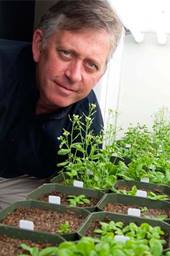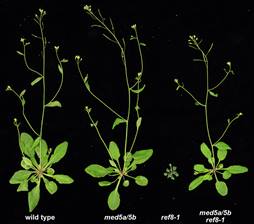Squaring the Circle in Biofuels?
Photo courtesy of Clint Chapple
Photo shows wild type Arabidopsis, a plant with just the two Mediator mutations, a dwarf mutant with reduced lignin production, and a mutant with all three mutations, restored to wild-type size.
A major goal of research into plants for next-generation biofuels is to coax Nature into doing two essentially opposite things at once. On the one hand, we want biofuel crops to be resilient and survivable in the field. On the other hand, we want these same plants to dissolve and yield up their precious sugars with a minimum of resistance during processing. The objective of next-generation biofuel production is to convert the sugars locked in the inedible leaves, stems, and trunks of plants—i.e., in plant fiber—into liquid fuels. But the very feature that makes plant fiber resilient, and helps plants to survive in the field, makes these sugars extremely difficult to extract.
In the parlance of biofuels research, the problem is known as "recalcitrance." At the core of recalcitrance is a substance called lignin. Lignin gives plants their stiffness and makes wood hard. It also helps solidify the channels through which the plant nourishes itself by drawing water up from the soil, as if through so many microscopic straws. But this same lignin is also very effective at shielding the plant's sugars—in the form of polymer chains called cellulose and hemicellulose—from external threats, including weather, animals, insects, microbes, and even human beings seeking to convert plants into biofuels.
Researchers have sought to overcome recalcitrance by weakening lignin through genetic engineering. Until recently, however, many of these efforts have had a predictably damaging effect on the overall structural integrity and growth of the plant—producing, for example, dwarf mutants with only a fraction of the usual sugars. But now a team led by Purdue University researchers seems to have overcome the trade-off, at least at first glance, by engineering a plant with a new form of lignin that is much more amenable to processing but also seems to support normal growth and sugar levels.
In achieving this result, the research drew on the resources and expertise of three major institutions—Purdue University, DOE's National Renewable Energy Laboratory (NREL), and the University of Wisconsin-Madison (UWM). Spearheaded by an individual investigator at Purdue receiving core program funding from the DOE Office of Science, the research also involved partnerships with both a DOE Energy Frontier Research Center (EFRC) and a DOE Bioenergy Research Center (BRC). In this way, the work demonstrated the inherent multidisciplinary nature of today's advanced basic research in energy—and showed how new methods of organizing research developed by DOE's Office of Science in recent years are helping to accelerate breakthroughs by fostering new kinds of partnerships and collaborations.
“The great benefit of the new form of lignin was to make sugars much more accessible to processing.”
Led by Purdue Distinguished Professor of Biochemistry Clint Chapple, along with postdoc Nicholas Bonawitz, the research focused on the "model plant" Arabidopsis—sometimes referred to as the "lab rat" of plant research. Arabidopsis was the first plant to have its genome fully sequenced, in 2000. It has a short lifecycle, measured in weeks, which means that the plant can go through several seasons of planting in a limited period of time. And it grows well in the confined conditions of a laboratory.
Chapple and his team took a mutant of Arabidopsis in which a key gene associated with lignin production was altered. The resulting plant, with much-reduced lignin production, was dwarfed in size and deficient in sugar content. It also failed to flower normally and was sterile.
Drawing on previous work, the researchers then introduced two additional genetic mutations resulting in changes in a protein complex known as Mediator.
Mediator has its own fascinating history, with an interesting DOE angle. It is a large protein complex that plays a key role in facilitating and regulating transcription of DNA into corresponding RNA. It is present in all eukaryotes, or cells with a nucleus, whether in plants, animals, or humans. Mediator was discovered by Roger Kornberg of Stanford University, who won the 2006 Nobel Prize in Chemistry for his work in this area. To study the structure of these proteins, Kornberg made extensive use of a DOE scientific user facility: the Stanford Synchrotron Radiation Lightsource at DOE's SLAC National Accelerator Laboratory. So in some sense, Chapple and colleagues were building on, or at least benefiting from, previous DOE-facilitated research.
In their own earlier work, Chapple and team had identified two genes associated with Mediator that kept lignin biosynthesis at normal levels.
The trick in this experiment was to combine all three mutations. When the two genetic mutations associated with Mediator were combined with the original mutation inhibiting lignin production, lignin production returned to near-normal levels.
Instead of a dwarfed plant, the result was a mostly normal-size plant with sugar levels essentially equal to those of the wild type of the species. The new plant also flowered normally and produced normal seeds.
 Photo courtesy of Clint Chapple
Photo courtesy of Clint Chapple
Purdue University's Clint Chapple shown with Arabidopsis plants in cultivation.
But there was an interesting twist, discovered when the plants were subjected first to electron microscopy and later to nuclear magnetic resonance (NMR) and chemical analysis. For electron microscopy, Chapple was able to turn to two experts in plant cell microscopy—Bryon Donohoe and Peter Ciesielski—at DOE's National Renewable Energy Laboratory in Colorado. This collaboration was facilitated by the fact that Chapple is also a principal investigator in the Center for Direct Catalytic Conversion of Biomass to Biofuels (C3Bio), a DOE Office of Science-sponsored EFRC led by Purdue, with NREL as a major partner. The plant NMR analysis work, led by John Ralph, a nationally recognized leader in the field, was performed at the Great Lakes Bioenergy Research Center, one of the three BRCs sponsored by DOE's Office of Science and led by UWM. UWM has one of the leading NMR research facilities in the nation. Ralph is also co-inventor of a specialized method of chemically analyzing lignin.
The surprise resulting from these analyses concerned not just the quantity, but also the composition of lignin in the new plants. There are actually three different types of lignin—known as H, G, and S—based on three different alcohols from which the lignin is synthesized. In normal, wild-type Arabidopsis, G and S lignin predominate, with only about 2 percent of the H variety. In contrast, the analyses revealed the new plant's lignin to contain about 95 percent of the H type.
The great benefit of the new form of lignin was to make sugars much more accessible to processing. After Purdue collaborator Michael Ladisch's team pretreated the samples with hot water and performed a 24-hour treatment with standard commercial enzymes, the new plant released 80 percent of its sugars, as opposed to just 50 percent for the wild-type Arabidopsis (and roughly 50 percent also from a mutant incorporating the mutations to Mediator but not the mutation relating to suppressing lignin production).
The exact mechanism by which the mutations affecting Mediator produce the effect remains to be understood. It is not clear whether Mediator is regulating genes that limit lignin production per se or rather directly limit the plant's growth. But the result opens up the possibility of developing plants with a type of lignin that, in effect, squares the circle, providing resilience and survivability in the field while easing the difficulties and costs of converting plant fiber into biofuels.
—Patrick Glynn, DOE Office of Science, Patrick.Glynn@science.doe.gov
Publication
Nicholas D. Bonawitz, Jeong Im Kim, Yuki Tobimatsu, Peter N. Ciesielski, Nickolas A. Anderson, Eduardo Ximenes, Junko Maeda, John Ralph, Bryon S. Donohoe, Michael Ladisch, and Clint Chapple, "Disruption of Mediator rescues the stunted growth of a lignin-deficient Arabidopsis mutant," Nature, published online March 16, 2014.
Funding
DOE Office of Science, Office of Basic Energy Sciences (Core Research, EFRC)
DOE Office of Science, Office of Biological and Environmental Research (BRC)
Life Sciences Research Foundation
Related Links
Clint Chapple Web Page at Purdue University


